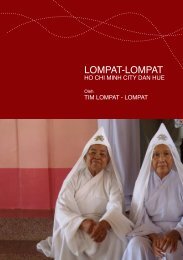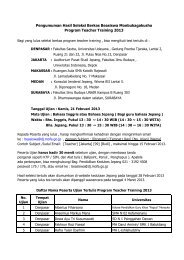9700_y16_sy
9700_y16_sy
9700_y16_sy
You also want an ePaper? Increase the reach of your titles
YUMPU automatically turns print PDFs into web optimized ePapers that Google loves.
Cambridge International AS and A Level Biology <strong>9700</strong> <strong>sy</strong>llabus Syllabus content<br />
10 Infectious disease<br />
The infectious diseases studied in this section are caused by pathogens that are transmitted from one<br />
human host to another. Some, like Plasmodium that causes malaria, are transmitted by vectors; others<br />
are transmitted through water and food or during sexual activity. An understanding of the biology of<br />
the pathogen and its mode of transmission is essential if the disease is to be controlled and ultimately<br />
prevented.<br />
Candidates will be expected to use the knowledge gained in this section to solve problems in familiar and<br />
unfamiliar contexts.<br />
Learning outcomes<br />
Candidates should be able to:<br />
10.1 Infectious diseases<br />
While many infectious<br />
diseases have been<br />
successfully controlled in<br />
some parts of the world, many<br />
people worldwide are still at<br />
risk of these diseases.<br />
a) define the term disease and explain the difference between<br />
an infectious disease and a non-infectious disease (limited to<br />
sickle cell anaemia and lung cancer)<br />
b) state the name and type of causative organism (pathogen) of<br />
each of the following diseases: cholera, malaria, tuberculosis<br />
(TB), HIV/AIDS, smallpox and measles (detailed knowledge of<br />
structure is not required. For smallpox (Variola) and measles<br />
(Morbillivirus) only the name of genus is needed)<br />
c) explain how cholera, measles, malaria, TB and HIV/AIDS are<br />
transmitted<br />
d) discuss the biological, social and economic factors that need<br />
to be considered in the prevention and control of cholera,<br />
measles, malaria, TB and HIV/AIDS (a detailed study of the life<br />
cycle of the malarial parasite is not required)<br />
e) discuss the factors that influence the global patterns of<br />
distribution of malaria, TB and HIV/AIDS and assess the<br />
importance of these diseases worldwide<br />
10.2 Antibiotics<br />
The ‘age of antibiotics’<br />
began in the 1940s with the<br />
availability of penicillin. With an<br />
increase in antibiotic resistance<br />
is this age about to come to an<br />
end?<br />
a) outline how penicillin acts on bacteria and why antibiotics do<br />
not affect viruses<br />
b) explain in outline how bacteria become resistant to antibiotics<br />
with reference to mutation and selection<br />
c) discuss the consequences of antibiotic resistance and the<br />
steps that can be taken to reduce its impact<br />
Back to contents page<br />
www.cie.org.uk/alevel<br />
29





